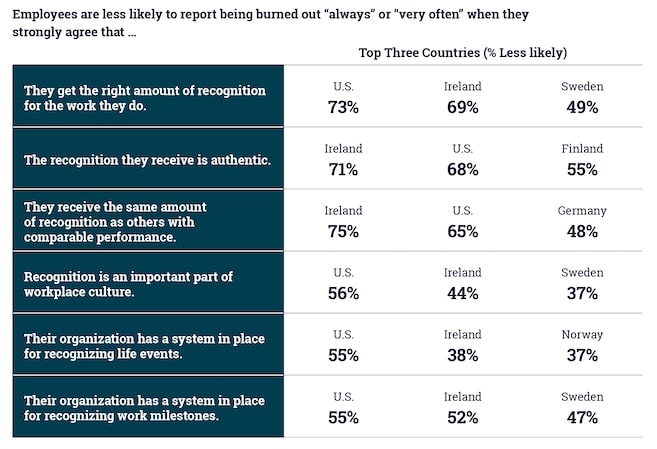What is Social Wellbeing? Understanding and Cultivating Wellness in the Workplace

“Wellbeing is a universal need of employees,” notes the new Workhuman and Gallup report, Amplifying Wellbeing at Work and Beyond Through the Power of Recognition. “And for organizations, it is a high-stakes foundation to organizational outcomes.”
Based on a large-scale study of more than 12,000 employees in 12 countries, the report goes on to identify the five essential elements of wellbeing — including social wellbeing — and the impact a strong employee recognition program can have on fostering positive relationships and wellbeing in the workplace. Keep reading to learn more.
What wellbeing means — and why it matters
As the report notes, wellbeing is about more than being healthy or happy — although those are certainly important.
Wellbeing “encompasses everything people do and everything that is most important in their lives: their careers, communities, and social connections; their physical health and mental health, their standard of living and financial stability. Well-being is a life well-lived; ignoring it is a costly mistake.”
As noted above, there are five essential elements that comprise employee wellbeing:
Career satisfaction
How do people spend their days? And do they generally like what they do with their time? Do they feel they have ample room to grow and support to develop their skills?
Financial health
What economic stability and standard of living do your employees have? Do they have the funds they need to provide for themselves and their family?
Physical well-being and mental health
What is the physical condition of your employees? Do they have the energy and endurance to be productive each day? Do they feel capable of managing their stress level? Are they supported when they are sick with insurance and sick time?
Community connection
This refers to people’s daily environment. Do they feel satisfied, connected, and engaged with the areas in which they live and work?
Social well-being (healthy relationships)
What is your employees’ relationship with others? Do they have healthy relationships, meaningful connections, and positive interactions?
Let’s dig into this last factor a bit more.
Why is social wellbeing important?

Humans are social creatures. Meaningful social relationships give us a sense of community and support that help us work toward common goals for the benefit of that social group.
In the workplace, supporting social wellness improves individual and organizational success because it shows employees that connection with one another is valued by their employers.
Social integration amongst team members leads to better collaboration and conflict resolution. Co-workers who connect on non-work subjects develop trust and better communication methods, increasing their efficiency and confidence to innovate in their roles.
For the individual employee, positive relationships at work help build emotional resilienceOpens in a new tab. For starters, our ability to manage stress improves with our level of social health. Interactions and relationships with others help us develop healthy habits like setting boundaries that can reduce stressors in the first place.
Employees who lack meaningful connections at work are up to 9x more likely to be disengaged, and as much as 3x as likely to be looking for a new job.
As the report explains, high employee wellbeing “prepares employees to excel in everything they do. Employees with high wellbeing perform better and lead happier, more fulfilled lives at the office and otherwise.”
Opposite of positive social relationships, social isolation can lower self-esteem, negatively impact health and contribute to absences, and diminish productivity."
For more workplace wellness statistics and in-depth reporting on links between wellbeing and critical business outcomes:
The cost/benefits of employee wellbeing
Neglecting overall employee wellbeing is one of the costliest mistakes an organization can make.
The Workhuman and Gallup report offers these hard statistics to prove the point:
- $20 million of opportunity loss for every 10,000 workers due to low wellbeing and its drain on performance
- $322 billion cost globally in turnover and lost productivity when low wellbeing shows up as employee burnout
Given the dramatic cost low social health generates, why don’t organizations do more to promote employee wellbeing?
According to the report’s findings, organizations tend to fixate on costly options such as Employee Assistance Programs (EAPs) and health insurance. And while those benefits have value, they overlook far more affordable and effective ways to boost wellbeing — such as a strategic employee recognition program.
Let’s take a deeper look at some ways organizations can use recognition and positive relationships to support employee wellbeing — including some key data points to inform your employee wellbeing strategy.
Improving social and emotional wellbeing in the workplace
Recognition magnifies social wellbeing
A positive workplace culture starts with a foundation of appreciation; when employees feel valued for their contributions, they feel better, and do better. And with the help of employee recognition tools, organizations can promote overall well being by connecting employees to one another as well as their work.
“Strategic recognition is related to lower levels of burnout at work, improved perceptions that the organization cares about wellbeing, and more positive life evaluations overall,” notes the report.
“Recognition is a force for good in workplaces globally — a ‘win-win’ strategy that supports business outcomes and people’s overall happiness and success in everything from their jobs to their levels of energy to their social health and integration.”
When you encourage socialization and building healthy relationships among employeesOpens in a new tab, you are not only improving their emotional wellbeing, you are also boosting employee engagement and creating a culture of inclusion.
- Employees who strongly agree that recognition is an important part of their culture are up to 91% more likely to be thriving.
- Employees who strongly agree that they get the right amount of recognition for the work they do are up to 84% more likely to be thriving.
- When employees give recognition at work at least a few times a month, they are as much as 2x as likely to be thriving.

Perhaps just as importantly, recognition helps insulate employees from negative feelings. In most of the countries included in the study, employees who agree that they receive the right amount of recognition are 20% to 40% less likely to report they feel a lot of stress, worry, or sadness.
“It can be the difference between a good week and a bad week at work. And you know, when people are happy and feel healthy and part of a team, the product is always better.”
In short, as the study points out, “Recognition is a powerful antidote for low social wellbeing, particularly when it’s given out freely among all employees.”
Promoting mental health and psychological wellbeing
In terms of employees’ overall mental health, social wellbeing has ramifications beyond the workplace. Those who lack social connections struggle to have positive emotions. They are far more likely to evaluate their overall lives negatively, and have a negative outlook on the future.
Far from having positive emotions, the report describes these employees as “suffering.”
“In fact, they are 13x more likely to be suffering than their colleagues with higher social wellbeing.”
Recognition and reward programs are effective tools for boosting employee self-esteem, reducing negative feelings of inadequacy which contribute to mental health factors like fear, stress, and anxiety.
Make time for social connection and recognition
Many think of having strong social ties as superfluous or a “nice to have.” But in fact, social bonds are a key underpinning of employee wellbeing, performance, and productivity.
“Organizations that know how to inspire employees to be their best selves and put in their best work take social wellbeing seriously,” the report explains. “Leaders who find strategic ways to make positive interactions commonplace can naturally promote great relationships.”
The report points out that managers can have a profound influence on employee wellbeing through their words and actions.
“Recognition is a simple and effective way for managers and leaders to demonstrate that they genuinely care about employees, and see their hard work,” the study notes. “In turn, this improves how employees feel about their jobs, their workplaces, and their lives overall.”
Employees who feel supported and appreciated are, in turn, more likely to support and recognize others.
The report reminds us that “A culture of recognition enriches employee wellbeing holistically — from employees’ social connection to their career aspirations … When recognition resounds at all levels of the company, it amplifies the benefit to everyone’s wellbeing.”
Shield employees from burnout
“Burnout has become so ubiquitous in today’s fast-paced, high-pressured work environments that the World Health OrganizationOpens in a new tab has defined it as an official syndrome, characterized by exhaustion, negativism or cynicism, and detachment,” notes the study.
For employers, this has real, bottom-line repercussions in the form of employees bringing less than their all to work. In fact, burned out employees are 63% more likely to not show up at all — and are 2x as likely to be looking for a new job.
So what can organizations do to reduce burnout among their employees? It all comes back to recognition.
The study’s research shows that employees who receive the right recognition at work are often 50% less likely to report being burned out always or very often.

According to the report, it’s vitally important that recognition be fair and equitable. “Seeing others get credit for your achievements or acknowledge for their work in ways you are not … is a common workplace experience that drains employees,” it explains. “This kind of treatment at work is one of the leading ‘root causes’ of burnout.”
Read our related article on How to Combat Burnout with Recognition & Wellbeing Programs for more.
Conclusion
Get the full story on how recognition can boost your employees’ wellbeing — and your bottom line.